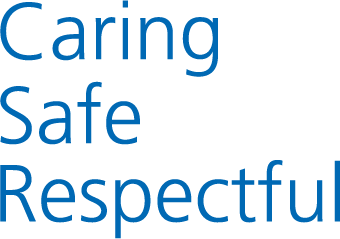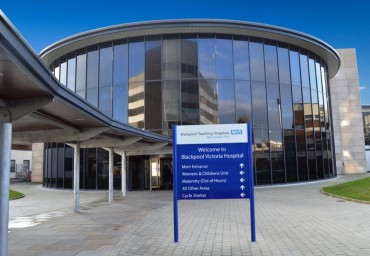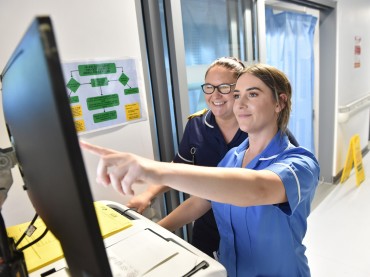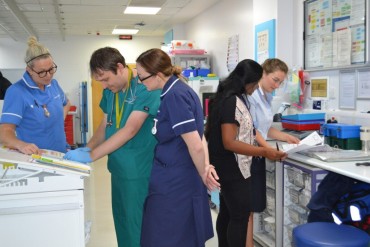Your eye may feel uncomfortable following treatment when the anaesthetic wears off. You may take pain relief for your comfort. Any pain relief you take for a headache should be sufficient.
Eye Pad
After surgery, you may be wearing an eye pad. Please DO NOT remove the eye pad until the time instructed by the surgeon.
REMOVE EYE PAD AFTER ________________ DAY(S).
Reduce eyelid swelling by sitting & sleeping upright
Sit upright as much as possible during the day, and sleep with your head propped up on 2 to 3 pillows at night for at least 3 days after surgery
Cool eyemasks / ice packs (when asked to do so)
If you ARE NOT wearing an eye pad – start this treatment as soon as you arrive home.
If you ARE wearing an eye pad – start this treatment after removing the eye pad at the time advised by the surgeon.
Procedure of ice pack treatment
• Sit upright and clean the eyelid(s)
• Place sterile gauze gently over the eyelid(s)
• Apply the icepack for 10 – 15 minutes (as tolerated) every hour for 3 days.
• Gently support the icepack by holding a clean cloth in your hand or wrapped around your head.
Please Note: A small bag of frozen peas or crushed ice, in a non-leaking clean plastic bag and wrapped in a clean cotton cloth would make a good icepack. DO NOT place ice directly on the skin. This can lead to an ice burn!
Eyelid cleaning
YOU WILL NEED: Sterile gauze & Cooled boiled water (freshly prepared each time) / or purchase Normal Saline sachets from the chemist.
WASH YOUR HANDS FIRST! and dry them on a CLEAN TOWEL.
Soak the gauze swabs in the cooled boiled water or Normal Saline and gently place on the eyelids to remove dried blood / superficial debris.
Gently dab the eyelids, moving the gauze sideways from the nose end towards the outside corner of the eyelid and avoiding the eye.
Clean the eyelashes from their base to their tips.
After the first clean, continue once daily cleans for 1 week. The frequency and duration of cleaning can be modified depending on the complexity of the operation and the appearance of the wound.
STITCHES: are quite secure but please be gentle.
If DISSOLVING STITCHES have been used, they MAY NOT need removing, but sometimes the Doctor will decide to remove dissolving stitches between 5 to 21 days after surgery.
If PERMANENT STITCHES are used, these are usually removed between 4 and 14 days after surgery. Rarely, if a graft has been taken from the ear or scalp, the stitches are left in longer.
How to apply your eyedrops or ointment
FIRST – ALWAYS WASH YOUR HANDS AND DRY THEM ON A CLEAN TOWEL!
After LOWER EYELID surgery: Gently pull down your lower eyelid and look up, then instil the drop into the gap between the lower lid and the eye. (Do not touch the eye with the dropper bottle). TAKE GREAT CARE NOT TO PUT ANY PRESSURE ON THE LOWER LID WITH YOUR FINGERS. If you are having a lower lid tightening procedure, please refrain from pulling the lid and apply the ointment externally on the SKIN around the wound(s) only. You may even be asked to apply a PLASTIC SHIELD over the eye at night to prevent inadvertent rubbing of the eye. Page 5 After UPPER EYELID surgery: Gently pull the upper lid up and look down, then instil the drop onto the eye. TAKE GREAT CARE NOT TO PUT ANY PRESSURE ON THE UPPER LID WITH YOUR FINGERS. Ointment may also be prescribed to apply gently on the skin around the wound(s).
| Medication | Eye / Side | Frequency |
Any further instructions:
Paracetamol or Codeine-based medication is advised for pain (if tolerated).
For at least 7 days after surgery, unless you regularly use these medications, avoid Aspirin or Non-Steroidal Anti-inflammatory Drugs (including Ibuprofen or Voltarol / Diclofenac) for pain relief.
Avoid exercise and especially swimming for 2 weeks after surgery.
Do not apply eye makeup for 2 weeks after surgery.
Bruising is common and can take between 10 to 21 days to disappear (it may extend to the cheek and even into the neck) – Light camouflage creams will help to disguise bruising.
The closure of the eyelids can be slightly impaired after any form of eyelid surgery, especially those involving the upper lid. This may take up to 6 weeks to fully recover. Therefore, to prevent dryness to the surface of the eye, it is essential that you comply with using lubricants that the surgeon would have prescribed if necessary.
You need to inform us urgently if you develop:
• Bulging of the eye
• Double Vision
• Eye discharge
• Blurred vision (unrelated to eye ointment)
• Excessive pain
• Bleeding
• Stitch breakage / wound opening
If you have any concerns or worries, please do not hesitate to contact the department on the below numbers:
Ophthalmic Surgical Unit, Monday – Friday 8am – 6pm, 01253 957421
Evening, weekends or bank holidays, Ward 14, 01253 953414



